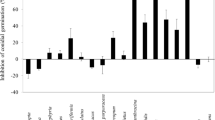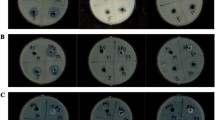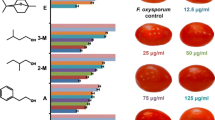Abstract
Three groups of volatile compounds, i.e., alcohols, aldehydes and esters, were tested for their effects on arthrospore germination and mycelial growth ofGeotrichum candidum citrus race, the causal agent of citrus sour rot. Alcohols (heptanol, octanol, nonanol, decanol, geraniol, citronellol) at a concentration of 1.0 μl/ml showed 60% or more inhibitory effects on both germination and mycelial growth of this pathogen. Among aldehydes tested, only citral had an inhibitory effect of more than 50%, while esters had no effect. The chain length of straight-chain (C6–C12) alcohols correlated with inhibitory effect, and nonanol (C9) was most active. Treatment with alcohols or citral prior to inoculation reduced colonization and maceration of lemon peel by this pathogen by 70% or more. Results suggested that alcohols or citral can probably be used to prevent the development of citrus sour rot.
Similar content being viewed by others
Literature cited
Asthana, A., Dixit, K., and Kishore, N. 1988. Toxicity of citral and eugenol against some storage fungi. Arch. Phytopathol. Pflanzenschutz24: 417–421.
Atkin, R. K., Spencer, D. M. and Wain, R. L. 1964. Investigation on fungicides: The antifungal activity of 2-deoxy-d-glucose. Ann. App. Biol.53: 437–443.
Ben-Yehoshua, S., Rodov, V., Kim, J. J. and Carmeli, S. 1992. Preformed and induced antifungal materials of citrus fruit in relation to enhancement of decay resistance by heat and UV treatment. J. Agric. Food Chem.40: 1217–1221.
Brown, G. E. and Eckert, J. W. 1988. Sour rot. In: Compedium of citrus diseases, (ed. by Whiteside, J. O., Gransey, S. M. and Timmer, L. W.), pp. 37–38. The American Phytopathological Society, St. Paul, Minnesota, USA.
Butler, E. E., Webster, R. K. and Eckert, J. W. 1965. Taxonomy, pathogenecity and physiological properties of the fungus causing sour rot of citrus. Phytopathology55: 1262–1268.
Davis, P. I. and Smoot, J. J. 1972. Germination ofPenicillum digitatum as affected by solutions of volatile components of citrus fruits. Phytopathology62: 488–489.
Eckert, J. W. 1978. Postharvest disease of citrus fruit. Outlook Agric.9: 225–259.
El-Tobshy, Z. M. and Sinclair, J. B. 1965.Geotrichum candidum: Plant and animal isolates pathogenic to certain plant tissues. Phytopathology55: 1210–1212.
French, R. C., Long, R. K., Latterell, F. M., Graham, C. L., Smoot, J. J. and Shaw, P. E. 1978. Effect of nonanal, citral and citrus oils on germination of conidia ofPenicillium digitatum andPenicillium italicum. Phytopathology68: 877–882.
Ghaout, A. E., Arul, J., Grenier, J. and Asselin, A. 1992. Antifungal activity of chitosan on two postharvest pathogens of strawberry fruits. Phytopathology82: 398–402.
Hershenhorn, J., Dori, S. and Barash, I. 1992. Association ofGeotrichum citri-aurantii with citrus groves in Israel. Phytoparasitica20: 31–36.
Horn, N. L., Sinclair, J. B. and Brown, R. T. 1958. The occurrence ofOospora rot of citrus in Louisiana. Plant Dis. Reptr.42: 262–265.
Kitagawa, H. and Kawada, K. 1984. Effect of sorbic acid and potassium sorbate on the control of sour rot of citrus fruit. Proc. Fla. State Hort. Soc.97: 133–135.
Kuramoto, T. 1981. Postharvest disease. In: Citrus diseases in Japan, (ed. by Miyakawa, T. and Yamaguchi, A.), pp. 27–32. N.Y.P., Tokyo.
Kuramoto, T. and Yamada, S. 1976. Df-125, a new experimental fungicide for control of satsuma manderin postharvest decays. Plant Dis. Reptr.60: 809–812.
Rodov, V., Ben-Yehoshua, S., Fang, D. Q., Kim, J. J. and Ashkenazi, R. 1995. Preformed antifungal compounds of lemon fruit: citral and its relation to disease resistance. J. Agric. Food Chem.43: 1057–1061.
Smith, C. O. 1917. Sour rot of lemon in California. Phytopathology7: 37–41.
Suprapta, D. N., Arai, K. and Iwai, H. 1995. Distribution ofGeotrichum candidum citrus race in soils of citrus groves and noncitrus fields in Japan. Mycoscience36: 277–282.
Wild, B. I., Rippon, L. E. and Nicoholls, P. J. 1976. Effect of decay between inoculation and SOPP treatment on the development ofGeotrichum candidum in oranges. Plant Dis. Reptr.60: 488–489.
Author information
Authors and Affiliations
About this article
Cite this article
Suprapta, D.N., Arai, K. & Iwai, H. Effects of volatile compounds on arthrospore germination and mycelial growth ofGeotrichum candidum citrus race. Mycoscience 38, 31–35 (1997). https://doi.org/10.1007/BF02464966
Accepted:
Issue Date:
DOI: https://doi.org/10.1007/BF02464966




